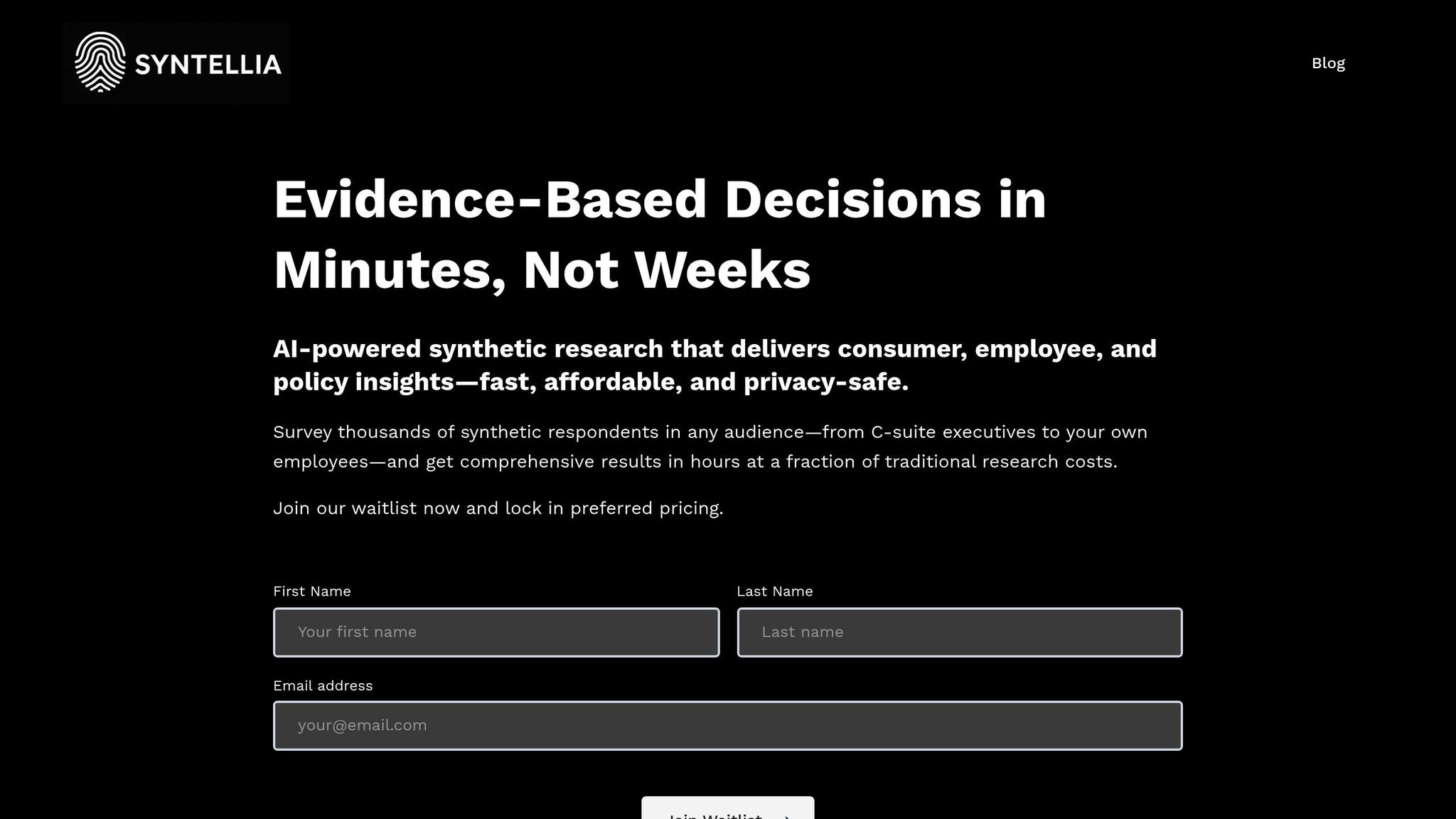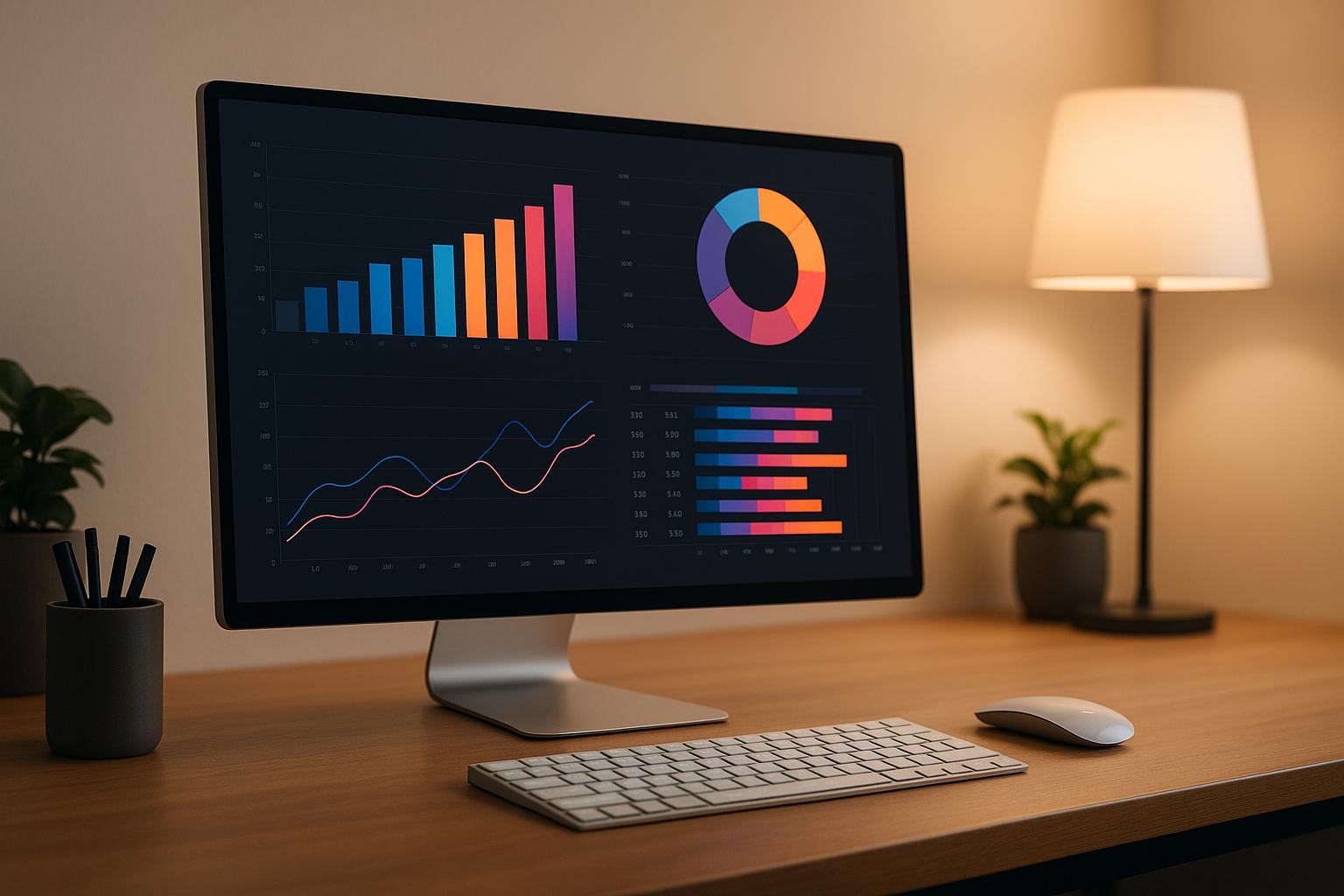AI is transforming how businesses predict consumer reactions. Instead of relying on slow, expensive methods like surveys or focus groups, companies are turning to AI for faster, more precise insights. Here's what you need to know:
- AI analyzes data in real time: It uses behavioral, transactional, and social media data to understand consumer preferences.
- It predicts future actions: By identifying patterns, AI forecasts how audiences will respond to campaigns or offers.
- AI reads emotions: Through sentiment analysis, it interprets tones and emotions in customer interactions.
- Synthetic research is a game-changer: Platforms like Syntellia simulate consumer responses in minutes, cutting costs by 90% compared to older methods.
This shift allows businesses to test ideas quickly, reduce risks, and create messaging that resonates, all while maintaining privacy by using virtual respondents. AI-powered tools are reshaping how companies approach decision-making in marketing.
How AI Predicts Consumer Reactions to Messaging
AI predicts how consumers will react to messaging by analyzing massive amounts of data to uncover patterns that might go unnoticed through traditional methods. By diving into this data, businesses gain a clearer, more precise understanding of consumer behavior, which helps them craft messaging that resonates more effectively. The insights AI delivers are rooted in its ability to process and interpret diverse data sources with remarkable speed and precision.
Data Sources AI Uses for Predictions
To build accurate consumer profiles, AI taps into a variety of data sources, creating a well-rounded picture of individual behaviors and preferences. For example:
- Behavioral data: This includes clicks, time spent on pages, and scrolling patterns.
- Transactional data: Purchase history, spending habits, and frequency of transactions fall into this category.
- Social media activity: Likes, shares, comments, and even the nuances of language used in posts provide valuable insights.
AI also gleans insights from customer interactions, such as support tickets, chat logs, and email exchanges. These interactions reveal key pain points and highlight what consumers find satisfying or frustrating. Additionally, modern AI systems can analyze unstructured data, like images and videos, to pick up on visual and emotional cues that might otherwise go unnoticed.
A great example of this in action is Netflix. The streaming platform uses AI to analyze data such as viewing history, search behavior, pause points, and even the time of day users watch content. This approach influences around 80% of what subscribers watch and reportedly saves Netflix about $1 billion annually by improving customer retention.
How AI Forecasts Consumer Behavior
AI doesn’t just analyze past behavior - it uses that information to predict future actions. Machine learning algorithms excel at identifying subtle patterns within vast datasets, connecting past behaviors to potential future outcomes.
For instance, AI can detect small signals that indicate purchasing intent, like frequent visits to a product page or adding items to a cart without completing the purchase. Predictive models then use these insights to estimate how consumers might respond to specific messages or offers in the future.
Amazon’s recommendation engine is a prime example of this. By analyzing purchase history, browsing habits, and demographic data, the platform predicts what products a customer might want - even before they start searching. Amazon’s patented "anticipatory shipping" system, introduced in 2013, takes this a step further by predicting where to stock products geographically, ensuring they’re closer to potential buyers.
How AI Reads Consumer Emotions and Opinions
AI goes beyond predicting actions - it also interprets the emotions that drive those behaviors. Using Natural Language Processing (NLP), AI can analyze the tone, sentiment, and emotional context of written communications, whether it’s a customer service email, a social media post, or a survey response.
Sentiment analysis digs deeper than a simple positive or negative label. It identifies nuanced emotional states like curiosity, frustration, or excitement. Behavioral indicators, such as how quickly someone clicks or how long they linger on a particular section of a page, add another layer of emotional insight.
AI’s social listening tools also monitor conversations across platforms, picking up on emerging sentiment trends before they become mainstream. By combining linguistic analysis with behavioral data, AI creates a detailed emotional profile for different consumer groups. This allows businesses to predict not only how a message will land but also the emotions it’s likely to evoke.
These capabilities highlight the growing impact of AI on marketing and productivity. McKinsey estimates that AI could contribute up to $4.4 trillion in global productivity, with marketing alone benefiting by an estimated $463 billion annually.
AI-Powered Synthetic Research: A New Way to Test Messaging
Traditional market research can be a slow and expensive process - recruiting participants, scheduling sessions, and waiting weeks for results, all while spending tens of thousands of dollars. Enter AI-powered synthetic research: a faster, more cost-effective way to gather insights by using virtual respondents. With this approach, businesses can test messaging strategies and get actionable feedback in just minutes.
What AI-Powered Synthetic Research Involves
At its core, synthetic research leverages AI to create virtual respondents that mimic real consumer behavior with impressive precision. These AI models are trained on vast consumer datasets, enabling them to simulate targeted demographics and behaviors.
Unlike traditional methods, synthetic respondents are available immediately. They can evaluate messaging, answer questions, and provide feedback just as real consumers would - without the hassle of recruitment, scheduling, or participant no-shows. Even better, these AI models can simulate thousands of consumer profiles at once, offering insights across multiple audience segments in a single session.
Why Platforms Like Syntellia Are Game-Changers

Platforms such as Syntellia are transforming how businesses conduct messaging research. Instead of waiting 6–12 weeks for results, companies can now get insights in just 30-60 minutes. This speed allows for rapid iteration, enabling businesses to refine their messaging strategies much faster.
Then there’s the cost. Traditional research can cost anywhere from $50,000 to $250,000 per project. Synthetic research, on the other hand, delivers similar insights at 90% lower costs. This affordability makes it possible for companies to test multiple messaging variations and explore different audience segments without exceeding their budgets.
Privacy concerns? Not an issue here. Because synthetic research uses virtual respondents rather than real people, there’s no risk of data breaches or confidentiality violations. This makes it ideal for testing sensitive messaging or exploring confidential product ideas.
Flexibility is another major advantage. While traditional methods often lock businesses into predefined questions and rigid methodologies, platforms like Syntellia allow for real-time adjustments. You can tweak questions and scenarios on the fly, enabling a more dynamic exploration of consumer reactions and sharpening the AI's predictions.
Practical Applications for Messaging Research
The versatility of synthetic research opens up a range of practical uses across marketing and communication channels:
- Email marketing: Experiment with different subject lines to pinpoint emotional triggers without risking engagement rates.
- Product launches: Simulate consumer reactions to various positioning strategies before committing to costly campaigns.
- Social media ads: Test variations in ad copy and calls-to-action across demographic groups to optimize performance.
- Customer service: Refine response templates and communication strategies without affecting actual customer relationships.
- Cross-cultural messaging: Use virtual respondents that reflect local values to fine-tune messaging before entering new markets.
This technology stands out for its ability to deliver accurate consumer predictions across these diverse scenarios. By enabling businesses to make data-driven decisions quickly and efficiently, synthetic research is reshaping how companies approach messaging strategies.
sbb-itb-2b2bc16
AI-Powered Research vs. Old Methods: Side-by-Side Comparison
Let’s take a closer look at how AI-powered research stacks up against traditional methods when it comes to key performance factors like speed, cost, accuracy, and privacy.
When business leaders weigh their research options, they need straightforward comparisons. The differences between traditional research and AI-powered synthetic research are striking, especially when you break them down into measurable metrics.
Comparison Table: Speed, Cost, Accuracy, and Privacy
| Factor | Traditional Research | AI-Powered Research (Syntellia) |
|---|---|---|
| Timeline | 6–12 weeks | 30–60 minutes |
| Cost | $50,000–$250,000 per study | 90% cost reduction |
| Accuracy | Variable - often impacted by sampling biases | 90% behavioral accuracy |
| Privacy | Requires handling sensitive personal data | Complete privacy protection (no real respondents used) |
| Iteration | Lengthy cycles for updates | Real-time adjustments |
The table makes it clear: AI-powered research is faster, more cost-effective, and provides higher accuracy while maintaining strict privacy standards.
For instance, traditional research can take months to complete and comes with a hefty price tag, often ranging from $50,000 to $250,000 per study. In contrast, AI-powered platforms like Syntellia deliver insights in just 30–60 minutes, cutting costs by 90%. This means businesses can reallocate those savings to further testing or other strategic initiatives.
Accuracy is another game-changer. Traditional methods often struggle with sampling biases, which can skew results. AI-powered research achieves up to 90% behavioral accuracy, offering reliable, actionable insights without the usual delays and complications.
Privacy is a growing concern in today’s data-driven world. Traditional research requires collecting and managing sensitive personal data, raising ethical and logistical challenges. AI-powered research sidesteps this entirely by using virtual respondents, ensuring complete privacy while still offering access to diverse audience profiles.
And let’s not forget about flexibility. Traditional methods involve time-consuming updates whenever adjustments are needed. With AI-powered research, real-time iteration becomes possible, allowing businesses to adapt quickly as market conditions evolve.
In short, AI-powered research isn’t just faster or cheaper - it’s a smarter way to make data-driven decisions in today’s fast-moving markets.
Conclusion: Using AI for Better Messaging Decisions
AI-driven synthetic research offers a powerful combination of speed, precision, and affordability, eliminating the need to compromise between these essential factors when refining messaging strategies.
Key Takeaways
Traditional research methods simply can't keep up with the pace of AI. Unlike conventional approaches that rely heavily on basic demographics and assumptions, AI excels at analyzing a wide range of data sources to uncover deeper insights.
For example, AI-powered synthetic research can deliver consumer insights with up to 90% accuracy in just minutes - at a fraction of the cost of traditional research methods. These cost savings open the door to testing multiple messaging variations without blowing your budget, allowing businesses to refine strategies and tap into new audience segments with ease.
Another major advantage? Privacy. With growing concerns about data collection, AI-powered research sidesteps these issues entirely by using virtual respondents. This ensures you can access diverse audience insights without compromising consumer trust.
With these tools at your disposal, the next step is clear.
Next Steps for Businesses
Harnessing AI's potential can revolutionize how you approach messaging. Start by identifying your most pressing messaging challenges and putting AI-powered solutions to work. Are you preparing a major campaign for the next quarter? Do you need to better understand a specific audience segment? These are ideal opportunities to leverage AI for testing and refinement.
Platforms like Syntellia showcase how AI can simplify research. With capabilities like surveys, focus groups, conjoint analysis, and A/B testing all in one place, you can address a variety of research needs without juggling multiple vendors or timelines.
Companies that adopt AI-powered research today gain the ability to make faster decisions, create more impactful campaigns, and respond quickly to shifting consumer preferences. In a competitive market, this kind of speed and flexibility can be the difference between leading your industry and playing catch-up.
The tools are available, the results are proven, and the cost savings are undeniable. Take action now to secure your edge in the marketplace.
FAQs
How does AI protect privacy while analyzing consumer data to predict responses to messaging?
AI systems take data privacy seriously, employing methods like anonymization, encryption, and secure storage to protect personal and sensitive information. These techniques allow data to be processed safely without compromising user privacy.
For example, platforms such as Syntellia use synthetic data or virtual respondents to mimic real-world behavior without relying on actual personal data. This strategy helps generate accurate predictions while upholding rigorous privacy standards. By combining these approaches, AI can responsibly analyze trends and preferences while keeping user information secure.
What makes AI-powered synthetic research better than traditional market research?
AI-powered synthetic research provides quick and precise insights by working with virtual respondent data. With 90% accuracy, it generates results in just minutes, significantly reducing both the time and cost associated with traditional research methods. This enables businesses to efficiently test messaging, adjust strategies, and make well-informed decisions - no need for drawn-out timelines or hefty budgets.
How can businesses use AI to predict consumer reactions and improve marketing strategies?
Businesses can use AI to better understand their customers and fine-tune their marketing strategies by focusing on three main areas:
- Personalization: AI studies customer behavior and preferences to offer tailored experiences. Think product recommendations or targeted ads that feel more relevant and engaging to individual users.
- Predictive Insights: By analyzing massive amounts of data, AI can identify trends, predict consumer needs, and guide businesses in creating strategies that truly connect with their audience.
- Efficiency and Optimization: AI takes over repetitive tasks, helps allocate budgets wisely, and delivers actionable insights. This allows businesses to make quicker, data-driven decisions without wasting resources.
With these tools, companies can build stronger connections with their audience, stay in tune with shifting preferences, and amplify the effectiveness of their marketing efforts.


